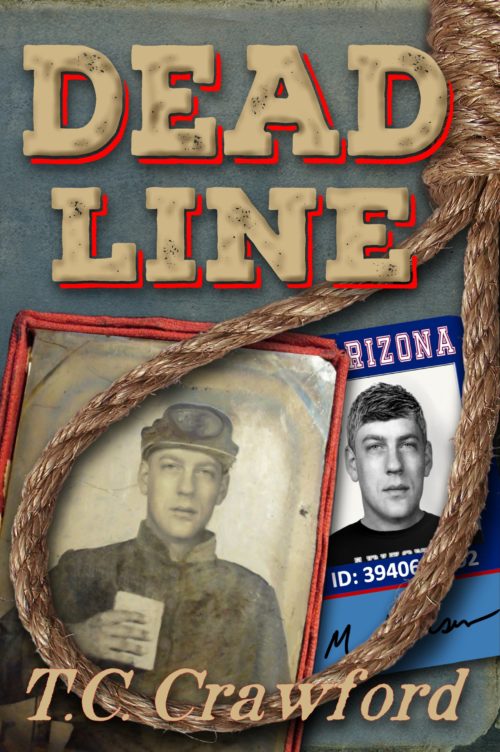The author says:
Two men. Two centuries. One destiny. Tom Dorin, a maimed and disillusioned veteran of the Civil War, builds a new life in the Arizona territory. Jon Hansen, a graduate student in Tucson, Arizona, finds an antique photograph in a decrepit roadside museum. A disturbing portrait of a long-dead man who could be his twin. Only two facts are known about the man in the tintype. His name was Tom Dorin. On March 13, 1874, he hanged. What begins as research into Tom Dorin’s life for a master’s thesis, becomes an obsession for Jon Hansen. An obsession that consumes every waking moment, and threatens every relationship in his life. Until the morning he wakes in Tom Dorin’s bed. In the Arizona Territory. On October 19th, 1873. Only one fact remains certain. It is recorded history, unalterable. On March 13, 1874, Tom Dorin hangs. No one knows why.
Nathan says:
What you’ve got here is well-rendered. However, I think some changes to the initial idea are in order for the cover to attract readers like it needs to, for a story that is essentially “Somewhere in Time meets Back to the Future III.” (Yes, that means a lot of work for you if you follow my critique. No, I’m not sorry.)
First: The strong red and blue elements of the cover call to mind not just a western, but a pulp western magazine from the thirties and forties. Since your story isn’t a standard shoot-’em-up, I think you may be giving the wrong impression and turning off the readers who would actually enjoy the story.
Second: The two different photos of the same face is a good idea in theory. However, to really work, the pictures need to be in complete parallel, directly across from each other, with each taking equal visual weight. Here, the tintype occupies much more space, but the isolated blue on the student ID, and the much starter monochrome in the modern picture, keep the two from being balanced. And while the cover makes sense once someone has read the synopsis, I don’t think it works the other way around, which is how it needs to work. And I don’t know if monkeying with the balance between the two pics will fix it.
If someone handed me that synopsis and asked me to design a cover, here’s what I’d do: A sepia-toned western street with people in period garb, and in the very center of the illustration, a figure in modern clothes in full color, facing away from the reader. I think the normal color at the center would draw the eye toward its natural center of focus, and the contrast between modern and period clothing would be very apparent, making it clear that this is a story about a modern man in the Old West. (I’d render the title in a distressed western font.)
Anyone have different ideas?


Nathan, I like your solution. My first impression was that these colors were very dull and kinda boring, even with the blue. A better font and more tonal contrast might help. Darks should be darker and lights, lighter.
My first thought on seeing the thumbnail for this cover was “old-time murder mystery.” It seems I was half right, anyway. On closer examination, I guess that modern I.D. card does hint at the time travel, but you’ve got your priorities switched: your readers’ primary interest is the part about the time travel. The mystery of why Tom Dorin got hanged (or hanged himself?) is the story’s MacGuffin: protagonist Jon Hansen’s primary interest, and therefore only of secondary interest to your readers. Also, that card looks just a little too cleanly rendered next to that gritty old photograph and rough-looking rope, suggesting a cut-and-paste job; and the modern photograph on that card looks like it’s gotten its aspect ratio squished, always a big no-no for those of us who also view this page’s sister site Lousy Book Covers.
Nathan’s proposed alternate cover is a good suggestion, but having that noose on the cover does strike me as an effective device for getting your prospective readers’ attention. If you go with his idea, therefore, I’d recommend two modifications to it: have that noose hanging in the foreground to frame your protagonist, and have him standing right in the middle of both your cover and the noose looking up at it with an apprehensive expression that says “That thing is being prepared for me!”
One other thing: you might want to work out some kind of compromise between his modernity and the older style of the person he’s replacing such as showing his head and hands and any other parts of him not hidden under his clothes in color, but the clothes themselves in the same sepia tone as the rest of the scene. That would give your prospective readers everything they need to know about what kind of story this is even before they take a look at the summary.
Technical notes, should you decide to stick with this basic design:
-The face on the student ID has the wrong aspect ratio. (This is REALLY visible since it’s right next to the same face with the correct aspect ratio.)
-The photo on the student ID has a white border around the top edge and the right side above the rope, but not the bottom edge or below the rope.
-The student ID is clearly computer-drawn and not a photograph. If it were real, the plastic would be shiny and there would be a visible edge.
-The shading of the rope and the tintype’s red backing don’t match their actual shadows, and the shadows are too diffuse, making them look like they’re hovering.
-Cut and paste artifacts are visible on the tintype.
-Different elements are different resolutions. The rope is very high resolution, but the tintype backing and the background texture are lower resolution, which is visible at full size.
-The title font needs to be anti-aliased.